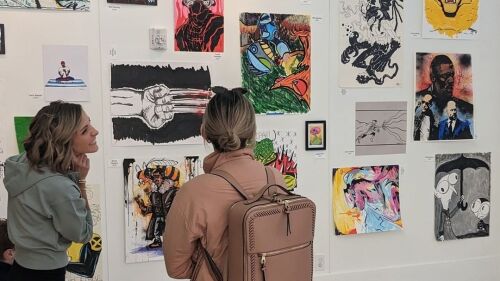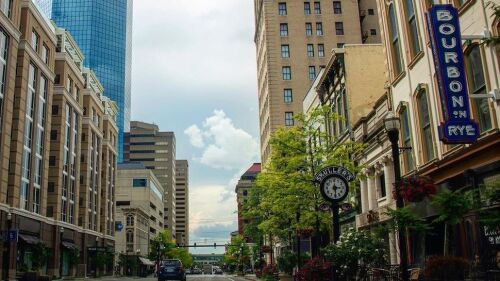Keeneland season is in full swing here in Lexington + all eyes will be on the ponies for the next few weeks. And during this time of year, it’s common for legends and stories to resurface; John Henry, American Pharoah, Seabiscuit, War Admiral — the list goes on.
But today’s convo isn’t a stallion story, it’s about a man who devoted his life to caring for one of the most famous and beloved horses to ever live — Will Harbut.
Will Harbut was Man o’ War’s groom for 16 years — from the fall of 1930 until the spring of 1946. And today, we’re taking a look at his life + his legacy.
Early life
Will Harbut was born in Lexington in 1885, eventually moving to Maddoxtown, KY as a young man. Maddoxtown is now a part of Fayette County, but in the late 1800s, was one of the many “free towns” popping up in central Kentucky after the Civil War.
Free towns were small communities that were settled by former slaves. It was in these newly formed towns that African Americans could find security while raising their families.
Specific to the Bluegrass region, many of these small towns offered employment opportunities on both agricultural + equine farms. Maddoxtown was perfectly positioned in the middle of Kentucky’s Thoroughbred industry.
Career
Will worked for local horsemen to provide for his family — his wife Mary Lizzie Payne + their 12 children. He developed a reputation for being a skilled horseman, with some folks even calling him a horse whisperer.
While working at Glen-Helen Stud, a local farm manager took notice of Will’s work. Harrie B. Scott Sr. appreciated Will’s dedication much, that when he became the farm manager at Faraway Farm, he asked Will to come work with him as a full-time groom.
Man o’ War
By the time Will began at Faraway in 1930, Man o’ War had already been a stud for ~10 years — his racing career + glory days long behind him. And while Will never actually had the chance to see Man o’ War race, he did his research, diligently studying the horse’s racing records.
For the next 15+ years, the two would spend nearly every day together. Will did everything he could for Man o’ War — fed him, bathed him, groomed him, walked him, even brushed his teeth.
Herbert Haseltine, the sculptor who created the famous 3,000-pound statue of Man o’ War, wrote, “Will was Man o’ War’s groom, nurse, and friend all rolled into one. That horse would do whatever Will told him to do.”
When Herbert was in the process of constructing the larger-than-life statue, Will was there to assist — helping the horse elegantly strike his famous pose.
“Without Will’s friendly and intelligent assistance, I couldn’t have gotten on as quickly as I did. Man o’ War would carry out his instructions immediately, without having to be pushed or pulled.”
During the 1930s + 1940s, it’s estimated that 500,000+ people visited Will and Man o’ War at Faraway Farm. Will allowed Man o’ War to enjoy his fame + retirement and gave the legendary horse a voice — becoming the unofficial oral historian of his racing achievements.
Will’s monologues about Man o’ War were as bright and vibrant as the horse’s chestnut coat — entertaining everyone from race fans, to families, to royalty, and government officials.
While visitors gathered to watch the horse graze in the distance Will recollected the horse’s greatest achievements in his rich baritone voice:
- Five American records
- Seven track records
- The first North American Thoroughbred to exceed $200,000 in earnings
- Winner of 20 out of 21 races
- His son, War Admiral, a Triple Crown winner in 1937
One of Will’s favorite stories to tell was how the farm’s owner, Samuel D. Riddle, once turned down a $1 million offer for Man o’ War. As the story goes, the potential buyer’s offer was rejected, and he was told that “lots of men might have a million dollars, but only one man can have Man o’ War.”
Fame
As we’ve all heard before, fame can be a fickle thing + it was probably no different for Man o’ War. Will was adamant about giving the horse his privacy. He refused to wake him up from a nap if visitors arrived while he was sleeping. And no guests interfered with feeding time.
In 1941, Will + Man o’ War’s fame surpassed the Thoroughbred industry and transcended into American pop culture. They were photographed together and featured on the front cover of The Saturday Evening Post.
Death
Will took pride in his job every day for 16 years. He practiced patience + understanding with the animals and people he worked with on a daily basis.
He treated everyone equally, only ever giving special treatment to his friend Man o’ War, or “the mostest hoss in the world,” as Will would always refer to him.
One day, unexpectedly, in March of 1946, Will suffered from a stroke + battled its complications for more than a year after — eventually dying in October 1947.
The loss reverberated throughout the Thoroughbred community + affected Man o’ War. The legend of a horse passed away only a month later from, what some say, a broken heart.
Legacy
Today, Will’s stories + character live on in newspaper articles, history books, photographs, museums, and, most importantly, through his family.
Will is survived by family members who still have a presence in the horse racing community today.
Greg Harbut is the great-grandson of Will Harbut + the owner of Harbut Bloodstock, a Thoroughbred agency that specializes in breeding stock, management, and the sale of racehorses.
“I hope to continue my family’s legacy, and, one day, make my own significant contributions to the Thoroughbred industry,” said Greg. “I’m proud of how my great grandfather was able to provide for his family and advance his children’s education.”
In 2021, Greg started leading a lecture series at Wilberforce University, a private historically-Black university near Dayton, Ohio. His goal is to introduce more young African-American students to the horse racing industry.
Additionally, Greg helped found the Ed Brown Society — a program that focuses on increasing workforce growth for Black Kentuckians in the horse racing business.














